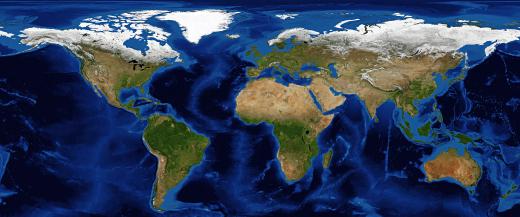What is the Difference Between the Continental Shelf and the Deep Ocean?
 Michael Anissimov
Michael Anissimov
In the world's oceans, there are two distinct geographic areas — the continental shelf and the deep ocean, also known as the abyssal plain. The continental shelf is a large area of shallow (less than 150 m, 500 ft) sea extending about 50 mi (82 km) from the world's continents. During Ice Ages, more water is locked up in the world's ice caps, the sea level decreases, and the continental shelves are exposed. Famous areas of continental shelf include the Siberian Shelf, which humans once crossed into the Americas, the Sunda Shelf in the South China Sea, the North Sea Shelf, and the Persian Gulf Shelf, all of which are thought to have once been inhabited by humans.
Outside the continental shelf, the continental crust gives way to the oceanic crust, usually a different tectonic plate. The depth increases, with the bottom sloping at an angle between 1° and 10°. Under a depth of about 0.9 km (3,000 ft), sunlight can no longer reach the ocean's depths, and pressure is about 90 times greater than at the surface, equivalent to the pressure at the surface of Venus. Only certain animals can survive at depths greater than this, as ecosystems must depend either on detritus that falls from above or chemotrophic bacteria feeding on hydrothermal vents or cold seeps at the bottom. In the completely dark environment, many animals are capable of generating their own light — an ability known as bioluminescence.

Most of the world's marine life is found on the continental shelf, where it is well-lit. This marine life includes representatives from 37 of all 38 animal phyla: only one phylum, the velvet worms, lack a marine version. Corals and sponges create a colorful bottom, and thousands of species of fish dodge predators among kelp forests. Off the continental shelf, there is also life, but most of it is within 150 m (500 ft) of the surface.
The dark abyssal plains covering most of the ocean floor are largely deserts, devoid of life. Some species that do live here include nematodes, giant isopods, and exotic primitive fish such as the blobfish.
AS FEATURED ON:
AS FEATURED ON:












Discuss this Article
Post your comments